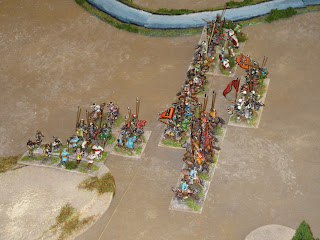Continuing his campaigns in the northern provinces, Ardashir
I marched his army for one final campaign against the remaining members of the
Arsacid dynasty now in Armenia. The Armenian army of this period have heavily
armoured cavalry supported by a large number of light horse. Armenian
javelinmen are ideally suited for operations in rough ground and hilly country
and having the advantage of ‘home’ terrain will not be an easy opponent for the
Sassanid.
II/69a Sassanid vs. II/28b Other Armenian
Terrain:
Hilly with two difficult hills, two wood and river.
Game 1
The open expanse between two difficult hills with a
river flowing between sliced a large area of battlefield. This posed a problem
for the mobile Sassanid who would now be forced to manoeuvre in deeper
formations. The Armenian anticipated
this and would use its mountain troops to seize the key hill to outflank the
Persians.
The main force of Armenia moved slowly forward to
allow time for its infantry to take a flanking position. This precipitated an
all out attack by the Sassanid.
In the following bounds, Ardashir and other nobles
broke through the Armenian line while enemy infantry were getting the better of
their fight with the Asavaran horse. The score was even 3 – 3.
On the next
Sassanid bound another cavalry unit succumbed to the infantry (4 - 3) but the
bound had not yet played out. Credit goes to Ardashir killing the Armenian king
bring the score 5g – 4 for Sassan.
Game 2
The second battle was fought in the ‘next’ valley.
Armenia would pursue a similar tactic of winning suitable ground for the
infantry to work their wonder.
A pip score of six raised their spirits and Armenian
infantry seized both wood while the main body closed the distance between the
two armies.
The Sassanid were blessed with an equally high score
and threw everything at the enemy including the ‘baking oven’. This resulted in
five combats resulting in four Armenian units destroyed. Score 4 – 0 for Sassan.
This was truly on of the most bizarre engagements of
all the matches to date lasting all of eight minutes.
Game 3
This final engagement brought both sides to an open
field nestled between difficult hills and a river. Due to the constricted
terrain Ardashir and his nobles formed the vanguard hoping to lure the Armenian
so as to make use of his Asavaran cavalry. The majority of the light horse were
sent to out flank the Armenian position and draw off their reserves.
Seeing the mass of Sassanid horse archers, the sole Armenian
light horse scampered back to cross the river. Likewise, two infantry were
despatched to secure impede any crossing giving the main body time to develop
its assault. Armenian javelinmen were successful securing the second hill.
The Armenian light horse turned to face it pursuers as
reinforcements were fast approaching. The main battle was well underway with both
sides taking losses.
The Armenian King valiantly fought off repeated
attacks despite the loss of supporting units. Quickly surrounded, the king
perished with his bodyguard leaving Ardashir I the victor. Score 4g – 3 for Sassan.













































